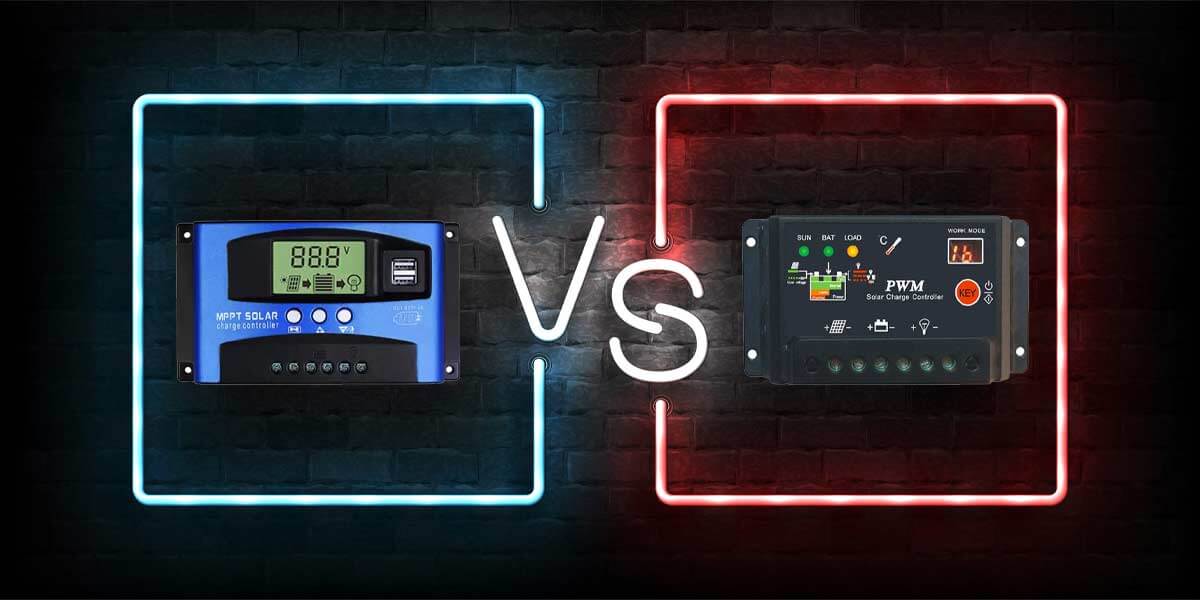MPPT VS PWM: Which Charge Controller Should You Buy?

Charge controllers are extremely important components in every solar installation, they are used with portable solar panels, in solar fence kits and many other solar kits. They ensure better efficiency of the solar system and boost up their functionality for years to come by.
Although many changing variables influence or impact the amount of power generated by the solar system, such as the level of sunlight, temperature, a battery’s state of charge, etc., charge controllers help to ensure that the batteries are well supplied with a packed level of power to function.
Let’s take a quick look at how they work and why we need them and discuss the type to opt for your solar system: MPPT VS PWM.
What Are Solar Charge Controllers And Why Do You Need It?

The solar charge controller is found between the energy source and storage, which prevents the overcharging of the batteries by limiting the amount of charge flowing to the batteries and at what rate. Not only that, but solar charge controllers also ensure that the battery is not drained by shutting down the system in case the store power falls between 50% of capacity.
They turn to change the battery voltage level and charge them to match the current capacity. Therefore, this helps to perverse the life and good health of the batteries and maintain their long life.
Thus, a solar charge controller helps bring out the optimum level of functionality of the solar batteries by providing them safety simultaneously. Some of their crucial functions include:
Overload Protection: In case the current flowing into the solar batteries is higher than the capacity of the circuit, the system is bound to overload. Therefore, this can lead to overheating and ultimately causing fire or permanent damages.
Thus, a solar charge controller helps to protect the batteries from overloading and, finally, keeping the system intact overall. In larger systems, we may also find a double safety protection system from circuit breakers or fuses.
Block Reverse Currents: As we may know, solar panels pump current through the solar batteries in one direction; during night hours, they may flow some of that current in the reverse direction as well, in case there’s no charge controller to limit the current. Thus, this can cause an immediate mild discharge from the battery, ultimately leading to damages.
Low Voltage Disconnects: A solar charge controller automatically disconnects non-critical loads from the battery if the voltage falls below a predefined threshold. It will automatically reconnect to the battery when it is being charged to prevent an over-discharge and dangerously low levels of voltage.
MPPT vs PWM Charge Controllers
What Is A PWM Charge Controller ?
The Pulse Width Modulation Controller or PWM was originally used in all solar systems since they were considered simple and cheaper than the MPPT controllers. They are, to an extent, like an electrical switch between the battery and the solar panels.
PWM controllers usually maintain the flow of energy to the battery by adjusting the current rate whenever necessary and hence, the name, pulse width modulation.
In simple words, PWM controllers regulate and reduce the amount of power flowing to the battery once the battery gets closer to getting fully charged as a preventive method to eliminate exerting stress or pressure on the battery.
However, PWM controllers are best for small-scale applications since the solar panel system, and batteries have to have matching voltages. This becomes much more complex with larger installations.
Pros And Cons Of PWM Charge Controllers
- They are more affordable and cheaper than MPPT solar charge controllers.
- They are available in a variety of sizes and are best for smaller systems with no critical efficiency.
- They are considerably more durable due to lesser chances of component damage.
- They perform the best when the battery is nearly complete and are available for systems up to 60 amps.
- They are well established and have been in use for many years.
- They are comparatively less efficient than MPPT charge controllers.
- The input voltage must match the battery bank voltage.
- They cannot accommodate larger systems, more than 60 amps and are best for warm and sunny weather.
What Is A MPPT Charge Controller?
The Maximum Power Point Tracking Charge Controllers or MPPT controllers, similar to the PWM controllers, are also efficient at using the full power of the solar panels to charge the solar batteries. One of their most significant advantage is that MPPT controllers keep an optimal charge voltage while requiring less time to charge the solar batteries fully.
Additionally, it allows reduced amounts of power loss as the conversion of excess voltage to amps allows greater voltage to travel through the solar panel to the controller.
For example, if it becomes cloudy, the MPPT Solar charge controller will decrease the amount of current rate to maintain an appropriate voltage at the output of the panel until it becomes sunny again.
Pros And Cons Of MPPT Charge Controllers
- They are highly efficient in charging and better than PWM charge controllers.
- They are best suitable for colder climatic regions.
- They are available for larger systems, up to 80 amps.
- They are ideal for situations where the solar array voltage is higher than the battery voltage.
- They can accommodate solar system growth and perform their best when the battery is low in charge.
- They are more expensive in comparison to PWM charge controllers.
- Also, they have an evidently shorter lifespan due to the presence of more components.
PWM Vs MPPT | Which Charge Controller Should You Choose?
Points to consider with MPPT charge controllers: Since MPPT controllers generally limit their output, you can make an array as large as you want, and a controller will limit that output. However, this also indicates that the current system is not as efficient as it should be since the solar panels are not properly utilized.
MPPT controllers do have an amp reading for it, for example, a 40 Amp MPPT Controller. Thus, even if the solar panels possess the potential to produce around 80A of current, an MPPT charge controller will only produce 40A of current regardless.
Points to consider with PWM charge controllers: On the other hand, PWM controllers do not limit their current output and simply use the array current.
This implies that if the solar array can produce about 40A of current, whereas the charge controller being used is only 30A, the controller will be damaged. Thus, it’s important to ensure that the charge controller is compatible with the solar panels being used.
Whether you want to buy PWM charge controllers or MPPT charge controllers, you can check our reviews on the best charge controllers that you can use in your solar panel setup.
Conclusion
Thus, with detailed research and weighing all the factors unique to a particular solar system installation, one should ideally opt for the type and size of charge controller suitable for the system.
Whether a person is living in the middle of the woods or a crowded city, the role of charge controllers remains the same and cannot be ignored. To conclude, whether PWM or MPPT, the choice of selection depends totally upon the type of solar system installed and the amount of efficiency required to obtain higher performance of the solar system.








